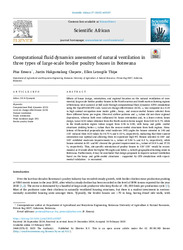| dc.contributor.author | Emesu, Pius | |
| dc.contributor.author | Chepete, Justin Hakgamalang | |
| dc.contributor.author | Thipe, Ellen Letsogile | |
| dc.date.accessioned | 2025-05-14T08:00:33Z | |
| dc.date.available | 2025-05-14T08:00:33Z | |
| dc.date.issued | 2025-03-07 | |
| dc.identifier.citation | Emesu, P., Chepete, J. H., & Thipe, E. L. (2025). Computational fluid dynamics assessment of natural ventilation in three types of large-scale broiler poultry houses in Botswana. Scientific African, e02587. | en_US |
| dc.identifier.uri | https://www.sciencedirect.com/science/article/pii/S2468227625000572 | |
| dc.identifier.uri | https://hdl.handle.net/13049/785 | |
| dc.description | Research article | en_US |
| dc.description.abstract | Effects of house design, orientation, and regional location on the natural ventilation of commercial, large-scale broiler poultry houses in the North-eastern and South-eastern farming regions of Botswana were assessed at full scale through computational fluid dynamics (CFD) simulations using the OpenFOAM CFD code. Local air change effectiveness (ACE), εL was computed in a 0.25 m high animal occupation zone inside gable-, hoop-, and seesaw-roofed houses selected from three different farms per region. Observed airflow patterns and εL values did not show regional dependence, whereas both were influenced by house orientation and, to a lesser extent, house design. Local ACE values obtained from the North-eastern farms ranged from 0.62 to 0.75, while in the South-eastern region values ranged from 0.56 to 0.90, with hoop- and gable -roofed structures yielding better εL values than the seesaw-roofed structures from both regions. Simulations of theoretical perpendicular wind incidence (WI) angles for houses oriented to 140 and 135° reduced their ACE values by 18.75 % and 0.53 %, respectively, indicating that their current orientation was optimal and allowing them to experience high WI. Houses oriented to 100° and 105° exhibited moderate improvements in εL values of 5.84 % and 6.4 %, respectively, while houses oriented to 95° and 90° showed the greatest improvement in εL values of 19.9 % and 37.52 %, respectively. Thus, site-specific orientation of poultry houses to 120°-150° would be recommended as it would allow for higher WI angles and better εL in both geographical farming zones in Botswana. Furthermore, it may be concluded that design proposals to improve natural ventilation based on the hoop- and gable-roofed structures – supported by CFD simulations with experimental validation – is warranted. | en_US |
| dc.language.iso | en | en_US |
| dc.publisher | Elservier | en_US |
| dc.relation.ispartofseries | Scientific African;Vol. 27, 2025 | |
| dc.subject | Computational fluid dynamics (CFD) | en_US |
| dc.subject | Local air change effectiveness (ACE) | en_US |
| dc.subject | Natural ventilation | en_US |
| dc.subject | House orientation | en_US |
| dc.subject | Wind incidence angle (WI) | en_US |
| dc.subject | Broiler poultry house | en_US |
| dc.title | Computational fluid dynamics assessment of natural ventilation in three types of large-scale broiler poultry houses in Botswana | en_US |
| dc.type | Article | en_US |

